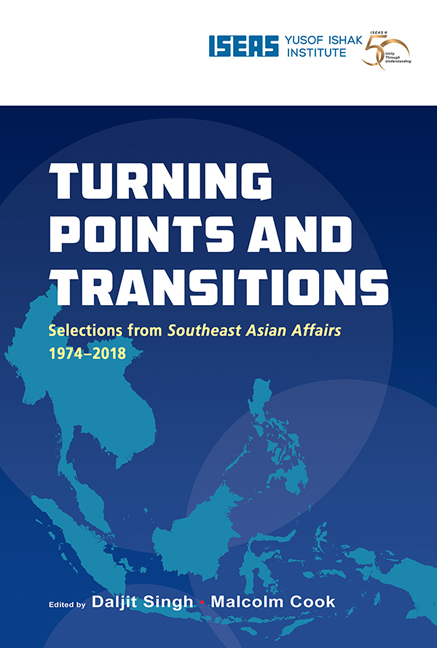Book contents
- Frontmatter
- Contents
- Message from the Director
- Foreword
- Foreword
- Introduction
- THE REGION
- BRUNEI
- CAMBODIA
- INDONESIA
- Indonesia's Armed Forces: Rejuvenation and Regeneration (1982)
- Indonesia: The Pancasila State (1985)
- The Indonesian Economy Facing the 1990s: Structural Transformation and Economic Deregulation (1990)
- A Year of Upheaval and Uncertainty: The Fall of Soeharto and Rise of Habibie (1999)
- Indonesia: The Regional Autonomy Laws, Two Years Later (2003)
- The Impact of Domestic and Asian Regional Changes on Indonesian Foreign Policy (2010)
- ISIS in Indonesia (2015)
- LAOS
- MALAYSIA
- MYANMAR
- THE PHILIPPINES
- SINGAPORE
- THAILAND
- VIETNAM
The Indonesian Economy Facing the 1990s: Structural Transformation and Economic Deregulation (1990)
from INDONESIA
Published online by Cambridge University Press: 29 May 2019
- Frontmatter
- Contents
- Message from the Director
- Foreword
- Foreword
- Introduction
- THE REGION
- BRUNEI
- CAMBODIA
- INDONESIA
- Indonesia's Armed Forces: Rejuvenation and Regeneration (1982)
- Indonesia: The Pancasila State (1985)
- The Indonesian Economy Facing the 1990s: Structural Transformation and Economic Deregulation (1990)
- A Year of Upheaval and Uncertainty: The Fall of Soeharto and Rise of Habibie (1999)
- Indonesia: The Regional Autonomy Laws, Two Years Later (2003)
- The Impact of Domestic and Asian Regional Changes on Indonesian Foreign Policy (2010)
- ISIS in Indonesia (2015)
- LAOS
- MALAYSIA
- MYANMAR
- THE PHILIPPINES
- SINGAPORE
- THAILAND
- VIETNAM
Summary
The decline in oil prices that started in the early 1980s adversely affected the Indonesian economy, partly contributing to the recession in 1982 and part of 1983. However, the decline in oil prices also forced the country to restructure its economy to one that is more diversified and balanced, and thereby more resilient to face the 1990s.
The new series of gross domestic product (GDP) figures announced in the presidential speech in Parliament on 16 August 1989 shows that the non-oil and gas sector grew at a rate faster than the oil and gas sector in the economy during 1983–88. The Indonesian economy grew at an annual average rate of 5.1 per cent during the Fourth Five-Year Plan period (1984–88). The GDP growth rates were 6.74 per cent in 1984, 2.47 per cent in 1985, 5.88 per cent in 1986, 4.98 per cent in 1987, and 5.65 per cent in 1988. The non-oil and gas sector grew by 4.91 per cent in 1984, 5.45 per cent in 1985, 6.24 per cent in 1986, 5.62 per cent in 1987, and 7.36 per cent in 1988.
The structure of production, pattern of export, and structure of government revenue all changed with the decline in oil prices. The importance of the non-oil and gas sector increased in the production structure while the reliance on oil and gas exports declined. Within the non-oil and gas sector the export of manufacturing products increased compared with that of primary products. Sources of government revenue shifted more from oil and gas taxes to income and value-added taxes.
Another major factor which contributed to the shift in the structure of production that resulted in an increase in the export of manufactured goods was the government's commitment to the liberalization of the economy. In this connection, financial market liberalization was one of the major programmes of the liberalization policy.
As a result of the above factors, the year 1989 also observed spectacular growth in its capital market. Within a short period of twelve months, market capitalization soared to 5 trillion rupiah from 1 trillion rupiah at the end of 1988. Several new banks comprising both national private banks and foreign joint-venture banks were opened in the country.
- Type
- Chapter
- Information
- Turning Points and TransitionsSelections from Southeast Asian Affairs 1974-2018, pp. 296 - 309Publisher: ISEAS–Yusof Ishak InstitutePrint publication year: 2018



